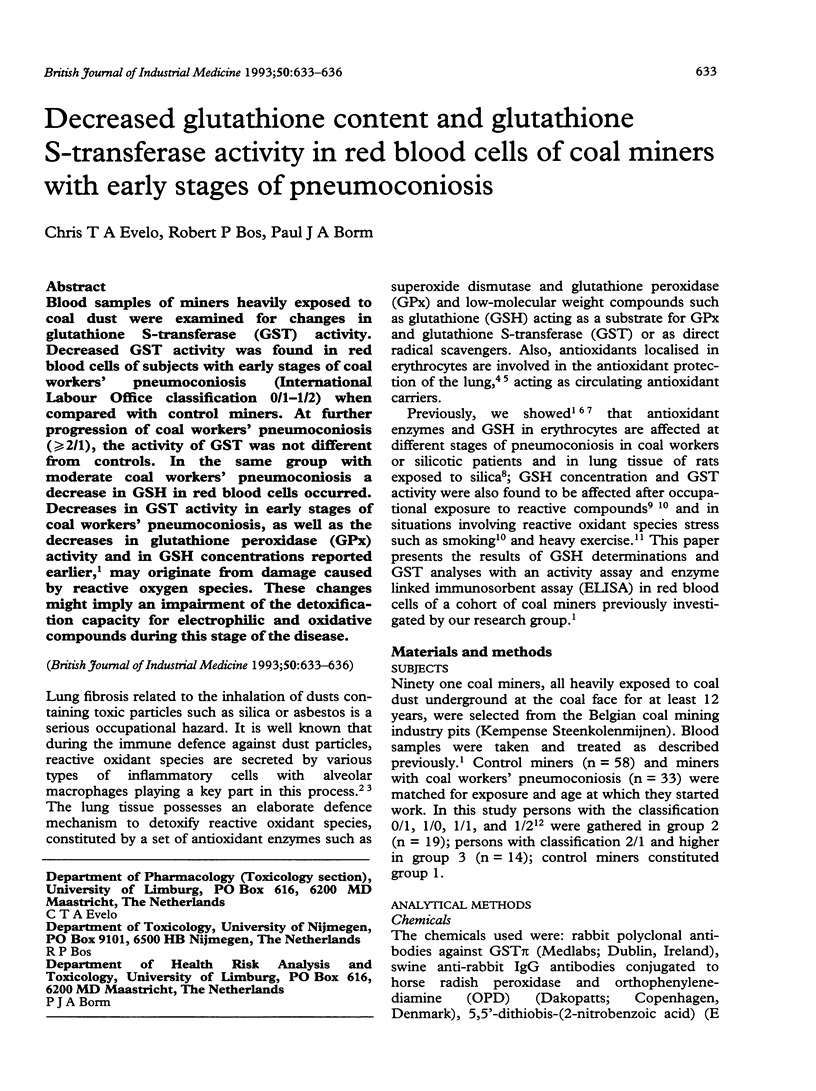Abstract
Blood samples of miners heavily exposed to coal dust were examined for changes in glutathione S-transferase (GST) activity. Decreased GST activity was found in red blood cells of subjects with early stages of coal workers' pneumoconiosis (International Labour Office classification 0/1-1/2) when compared with control miners. At further progression of coal workers' pneumoconiosis (> or = 2/1), the activity of GST was not different from controls. In the same group with moderate coal workers' pneumoconiosis a decrease in GSH in red blood cells occurred. Decreases in GST activity in early stages of coal workers' pneumoconiosis, as well as the decreases in glutathione peroxidase (GPx) activity and in GSH concentrations reported earlier, may originate from damage caused by reactive oxygen species. These changes might imply an impairment of the detoxification capacity for electrophilic and oxidative compounds during this stage of the disease.
Full text
PDF



Selected References
These references are in PubMed. This may not be the complete list of references from this article.
- Anderson M. E. Determination of glutathione and glutathione disulfide in biological samples. Methods Enzymol. 1985;113:548–555. doi: 10.1016/s0076-6879(85)13073-9. [DOI] [PubMed] [Google Scholar]
- Borm P. J., Bast A., Wouters E. F., Slangen J. J., Swaen G. M., de Boorder T. Red blood cell anti-oxidant parameters in silicosis. Int Arch Occup Environ Health. 1986;58(3):235–244. doi: 10.1007/BF00432106. [DOI] [PubMed] [Google Scholar]
- Bowden D. H. Macrophages, dust, and pulmonary diseases. Exp Lung Res. 1987;12(2):89–107. doi: 10.3109/01902148709062834. [DOI] [PubMed] [Google Scholar]
- Brouwer E. J., Evelo C. T., Verplanke A. J., van Welie R. T., de Wolff F. A. Biological effect monitoring of occupational exposure to 1,3-dichloropropene: effects on liver and renal function and on glutathione conjugation. Br J Ind Med. 1991 Mar;48(3):167–172. doi: 10.1136/oem.48.3.167. [DOI] [PMC free article] [PubMed] [Google Scholar]
- DeLean A., Munson P. J., Rodbard D. Simultaneous analysis of families of sigmoidal curves: application to bioassay, radioligand assay, and physiological dose-response curves. Am J Physiol. 1978 Aug;235(2):E97–102. doi: 10.1152/ajpendo.1978.235.2.E97. [DOI] [PubMed] [Google Scholar]
- Duthie G. G., Robertson J. D., Maughan R. J., Morrice P. C. Blood antioxidant status and erythrocyte lipid peroxidation following distance running. Arch Biochem Biophys. 1990 Oct;282(1):78–83. doi: 10.1016/0003-9861(90)90089-h. [DOI] [PubMed] [Google Scholar]
- Engelen J. J., Borm P. J., van Sprundel M., Leenaerts L. Blood anti-oxidant parameters at different stages of pneumoconiosis in coal workers. Environ Health Perspect. 1990 Mar;84:165–172. doi: 10.1289/ehp.9084165. [DOI] [PMC free article] [PubMed] [Google Scholar]
- Evelo C. T., Henderson P. T. Biological effect monitoring. Arch Toxicol Suppl. 1992;15:268–277. doi: 10.1007/978-3-642-77260-3_35. [DOI] [PubMed] [Google Scholar]
- Evelo C. T., Palmen N. G., Artur Y., Janssen G. M. Changes in blood glutathione concentrations, and in erythrocyte glutathione reductase and glutathione S-transferase activity after running training and after participation in contests. Eur J Appl Physiol Occup Physiol. 1992;64(4):354–358. doi: 10.1007/BF00636224. [DOI] [PubMed] [Google Scholar]
- Habig W. H., Jakoby W. B. Assays for differentiation of glutathione S-transferases. Methods Enzymol. 1981;77:398–405. doi: 10.1016/s0076-6879(81)77053-8. [DOI] [PubMed] [Google Scholar]
- Janssen Y. M., Marsh J. P., Absher M. P., Hemenway D., Vacek P. M., Leslie K. O., Borm P. J., Mossman B. T. Expression of antioxidant enzymes in rat lungs after inhalation of asbestos or silica. J Biol Chem. 1992 May 25;267(15):10625–10630. [PubMed] [Google Scholar]
- Kelley J. Cytokines of the lung. Am Rev Respir Dis. 1990 Mar;141(3):765–788. doi: 10.1164/ajrccm/141.3.765. [DOI] [PubMed] [Google Scholar]
- Rahman Q., Khan S. G., Ali S. Effect of chrysotile asbestos on cytochrome P-450-dependent monooxygenase and glutathione-S-transferase activities in rat lung. Chem Biol Interact. 1990;75(3):305–313. doi: 10.1016/0009-2797(90)90073-v. [DOI] [PubMed] [Google Scholar]
- Sibille Y., Reynolds H. Y. Macrophages and polymorphonuclear neutrophils in lung defense and injury. Am Rev Respir Dis. 1990 Feb;141(2):471–501. doi: 10.1164/ajrccm/141.2.471. [DOI] [PubMed] [Google Scholar]
- Toth K. M., Clifford D. P., Berger E. M., White C. W., Repine J. E. Intact human erythrocytes prevent hydrogen peroxide-mediated damage to isolated perfused rat lungs and cultured bovine pulmonary artery endothelial cells. J Clin Invest. 1984 Jul;74(1):292–295. doi: 10.1172/JCI111414. [DOI] [PMC free article] [PubMed] [Google Scholar]
- Van Kampen E. J., Zijlstra W. G. Determination of hemoglobin and its derivatives. Adv Clin Chem. 1965;8:141–187. doi: 10.1016/s0065-2423(08)60414-x. [DOI] [PubMed] [Google Scholar]


